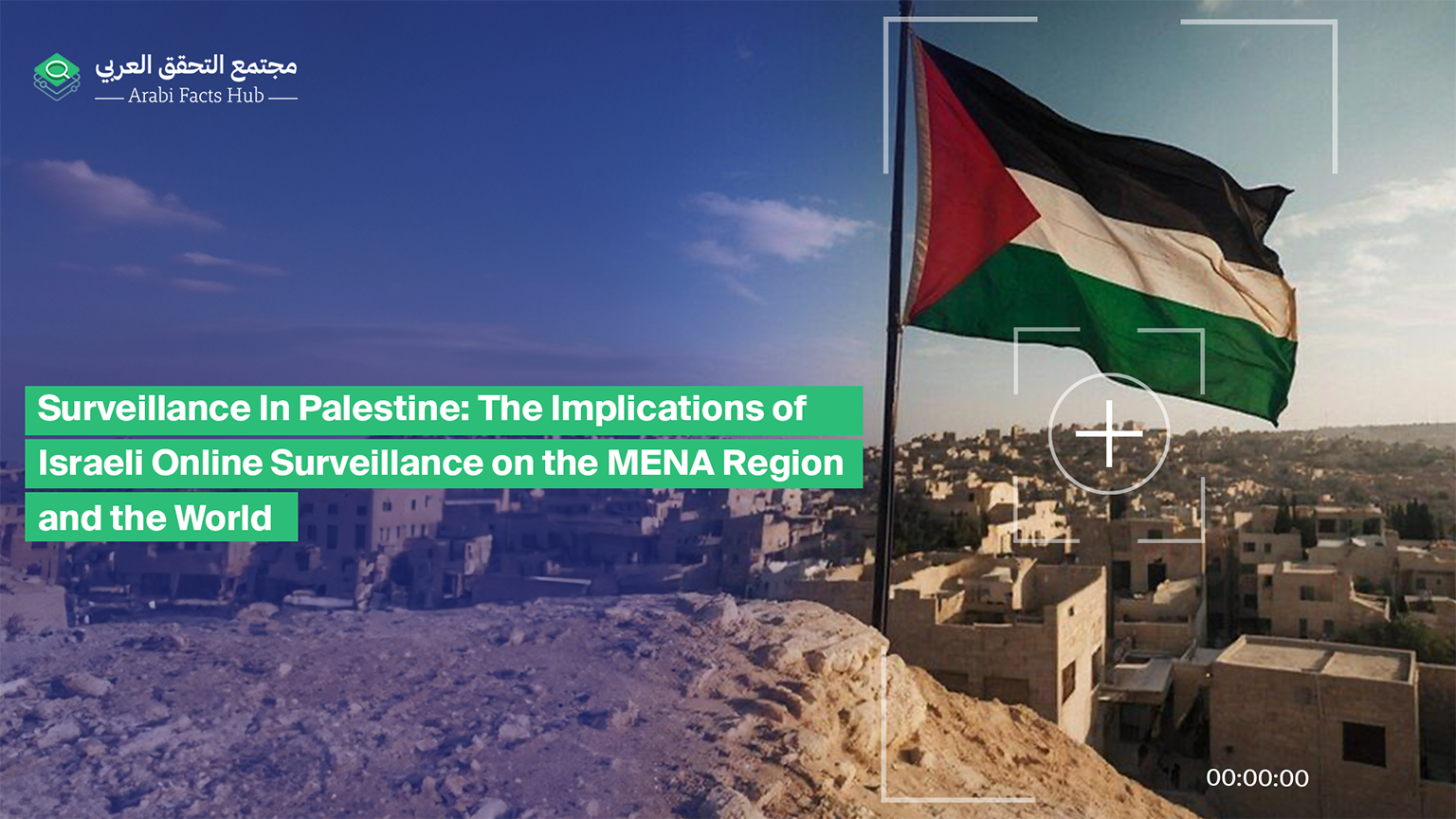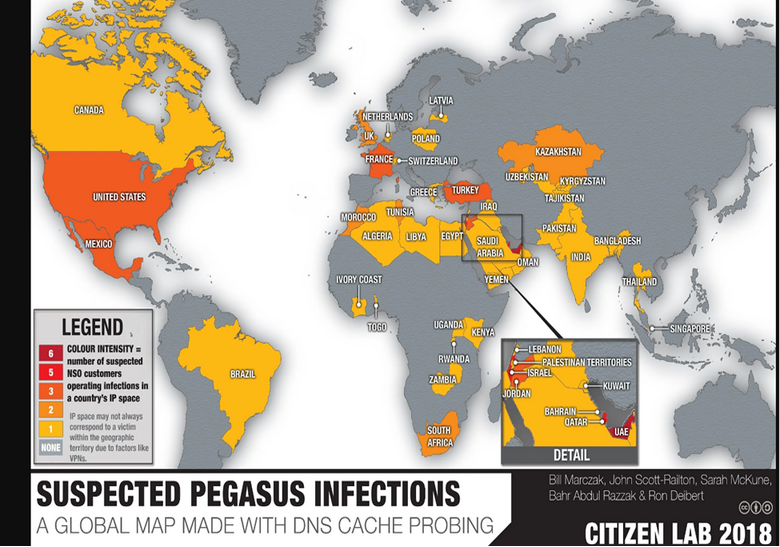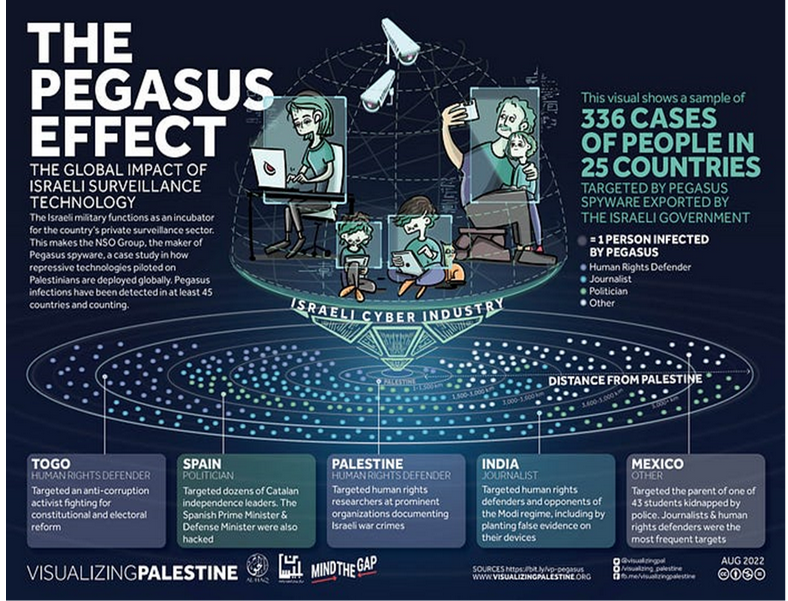Dr. Nijmeh Aliis a Palestinian academic and researcher specializing in political science, resistance movements, and the dynamics of Palestinian activism. She focuses on identity, citizenship, and the role of technology in political behaviour, advocating for Palestinian rights and digital sovereignty.
Surveillance In Palestine: The Implications of Israeli Online Surveillance on the MENA Region and the World

In the digital age, technology has transformed communication, access to information, and daily life. However, in contexts of domination, such advances have been also weaponized to become tools of surveillance, control, and oppression. Such is the case of Israel and Palestine, which highlights very strongly how technology can serve as a mechanism for sustaining and expanding domination. The Israeli authorities have built one of the most advanced surveillance systems in the world, making Palestinians its target under the disguise of national security; they have also promoted the sale of these products all over the world, often behind the rhetoric of technological advancement and as a response to crisis management, such as health crises.
Since the start of the COVID-19 pandemic and the Russian invasion of Ukraine, there has been an increased marketing and celebration of surveillance technologies as tools for protection and safety, with less attention to the fact that these technologies reinforce oppressive structures, especially in Palestine (the Occupied West Bank and Gaza Strip). For Palestinians, surveillance used by the Israeli occupation to monitor movements or as a means of enforcing control – ultimately a method of oppression to exert political and psychological pressure. This became particularly evident during the continued genocide in Gaza, with the New York Times recently reporting that surveillance technology was used in a major way since the start of the war. Israeli authorities, for example, deploy facial recognition at checkpoints in Gaza, scanning the faces of Palestinians passing through and detaining anyone with suspected ties to Hamas.
The implications of Israeli surveillance extend beyond Palestinians directly involved in the conflict. Activists, journalists, politicians, students, and others expressing opinions on the systems of apartheid that Israel imposes on Palestinians also face intimidation, harassment, and political persecution. Surveillance is therefore used as a tool to muzzle dissent, self-censorship, and shape public narratives globally.
This research explores the practice of Israeli online surveillance in Palestine, focusing on how these technologies are normalized and globalized. Their broader implications for privacy, freedom, and human rights highlight the risks of allowing these technologies to spread without accountability and emphasizes the need to carefully examine and control their use to people's basic rights everywhere.
Origins of Israel's surveillance regime: different tools with the same purpose
The use of surveillance in the oppression and displacement of Palestinians goes back to the pre-establishment of the Israeli state in 1948. During the colonial period, methods typical of other colonial settings, such as surveys, mapping, and reliance on human informers, were employed to establish systems of knowledge, power, and control. These techniques were essential to the Zionist colonial project, which aimed to displace the Palestinian people. Surveillance practices were adapted and expanded to enforce control, drawing parallels to global colonial strategies. This early use of surveillance laid the groundwork for more sophisticated systems that emerged later under Israeli governance.
Information, thus, is a cornerstone in the Zionist colonial project. In the late 1910s, the Zionist movement started gathering information about Palestinians for colonial purposes using various means of intelligence. Their first information gathering on land was conducted in 1919 by the World Zionist Organization (WZO) “Information Office” together with WZO Departments of Agriculture and Settlements and consisted of a detailed land survey of Palestine.
Between 1943 and 1948, a significant organization that collected maps for surveillance and population control of Palestine and constructed comprehensive lists of villagers and land holdings for military and settlement purposes, was Shai, the intelligence arm of the Hagana, established in 1940. Its operation, known as the ‘Village Files’, collected information including aerial photographs, maps, textual surveys, and socioeconomic data about the villages, as well as information on internal disputes, political affiliation, resistance involvement, water resources, land ownership, information on roads, the number of weapons available to Palestinians, and the presence of fighters during the 1936–1939 Revolt. This information was then used as an effective instrument in the ethnic cleansing of Palestine in 1948. Zionists also established various bodies that later evolved into the state’s “intelligence” institutions, including Shin Bet and Mossad, among others.
The pre-state period, therefore, ushered in the domination of surveillance as Israel’s first line of defense. This was particularly reflected in 1953, when David Ben-Gurion formulated the first and the only approved document on the Israeli national security doctrine, which was/still relies on three security elements: deterrence, intelligence, and a swift and decisive victory to end the war quickly. Therefore, not surprisingly, the Directorate of Israeli Intelligence (DMI or AMAN—Hebrew acronym) determines Israel’s policymaking process. AMAN’s Research Division serves as the leading national intelligence estimator, not only in military matters, but also in political, economic, and all matters considered relevant to state security.
Today, the physical spaces of the Occupied Territories, especially East Jerusalem and the West Bank, already subjugated to traditional and visible methods of monitoring and control checkpoints, the apartheid wall, and the blockade on Gaza, are now also covered with advanced surveillance tools.
Surveillance in Palestine is also reflected in the form of online surveillance. Today, in a time when extensive human communication pervades every aspect of life and is conducted via electronic media, the control modern technology for comprehensive-scale collection, storage, and statistical data analysis can yield more productive and detailed intelligence information on surveillance targets than ever before.
Thus, in order to understand surveillance in contemporary and technological times, we must consider digital colonialism, or the use of digital technology for political, economic, and social control. This is similar to “data colonialism”, a twenty-first-century expression of colonialism that normalizes “the exploitation of human beings through data, just as historic colonialism appropriated territory and resources and ruled subjects for profit.”
The development of Israel's surveillance industry was founded on close links between the military and technological sectors. As early as 1960, for instance, the Israeli military was creating computer software when the private industry for selling software in Israel did not yet exist and Israeli universities did not yet have a department of computer science. In addition, the prolonged occupation of the West Bank (with East Jerusalem included), the blockade of Gaza, and periodic Israeli wars most recent of which has been in Gaza, has led to a reality where “occupied Palestine effectively functions as an open-air laboratory for Israel to test techniques of espionage and surveillance before selling them to repressive regimes around the world."
The Israeli military operates in the cyber domain through two units: C4I Directorate and Unit 8200. C4I, which operates under the military’s Computer Service Directorate, is responsible for network security within the Israeli military, as well as for the development of ICT systems infrastructure, software, and cryptographic foundations for the military. Unit 8200, the Military Intelligence Directorate is responsible for the intelligence collection and code decryption unit, which carries out offensive cyber operations. Information gathered by Unit 8200 “ is used for political persecution and to create divisions within Palestinian society.”
To understand the militarization of the cyber security field, however, we can look to Unit 8200, which functions as an incubator for private Israeli cyber companies and tech entrepreneurs. Of the 2,300 Israelis who founded 700 Israeli cyber firms, 80 per cent were graduates of Unit 8200.
Therefore, it is not surprising that Israel is the headquarters of more spyware companies than any other country. Israel became a “leading exporter of tools for spying on civilians. Dictators worldwide—even in countries with no formal ties to Israel—use them to eavesdrop on human rights activists, monitor emails, hack into apps and record conversations."
Mass surveillance practices in Palestine: why and how?
Israeli surveillance has become a reality of everyday life for Palestinians who are subjugated to occupation, apartheid and settler-colonial systems; in this regard, surveillance in the colonial state is a “territory and population management as two parallel colonial activities.” In the Israeli case, the control over Palestinian land has been determined through wars in 1948 and 1967 and with the continuing land confiscation for the settlements, and the challenge has been shifted from "controlling the territory to managing the population.”
Israel’s widespread use of mass surveillance and targeted spyware upholds its systemic denial of numerous fundamental rights: privacy, freedom of movement, freedom from discrimination, freedom of expression and association, due process, and more. In order to understand how Israel may be able to impose surveillance on the ground or in the digital space, the control over the Information and Communications Technologies (ICT) in Palestine must be examined.
Since the Israeli occupation of the Palestinian territories in 1967, Israel took complete control of the ICT infrastructure and sector in the West Bank and Gaza, impeding development and blocking the establishment of an independent network, effectively making Palestinians entirely dependent on the Israeli occupation authorities. Despite Israel recognizing in the Oslo Accords that “the Palestinian side has the right to build and operate separate and independent communication systems and infrastructures including telecommunication networks, a television network, and a radio network,” it continues to control the telecommunication infrastructure and the deployment of services in most parts of the occupied Palestinian territories, resulting in severe violations of Palestinian digital rights. Israel, in other words, can listen to every telephone conversation taking place in the West Bank and Gaza. Every mobile or phone imported into Gaza through the Kerem Shalom crossing – in Gaza's south – is implanted with an Israeli bug, and anyone using the only two mobile networks serving the occupied territories – Jawwal and Wataniya – is monitored as well.
Israel’s continuous control over the ICT infrastructure has enabled Israel to monitor all Palestinian online activity, violating their right to privacy, and in many cases, cooperating with social media companies to censor Palestinians online, a violation of their right to freedom of expression.
Mass surveillance is also imposed on Israeli citizens – mainly Palestinian citizens in Israel – in line with a set of laws in the name of protecting Israeli national security. Israel has institutionalized surveillance through legislations that legitimize mass collection of data and monitoring, including two major laws involving internal surveillance of Israeli citizens that have been at the center of a very heated debate in the Israeli media and made it to court: "The Big Brother Law" and "The Biometric Database Law." The Big Brother Law, passed by the Knesset in 2007, enables the police to establish a database of citizens that includes telephone numbers, names of mobile telephone subscribers, serial numbers of mobile phones, and maps of antenna locations. This database has been referred to as the "biggest database in the West" The Biometric Database Law was enacted in 2009, where Israel created a biometric database and collected and stored biometric data, characteristic biological traits such as fingerprints, retina and iris patterns, and other unique identifiers.
Since 2015, Israel has been developing special units that report Palestinian content to social media companies. The "Cyber Unit" was developed by the Israeli Ministry of Justice to support Israel's National Cyber Crime Unit (Lahav 433) and the Israeli Law, Information and Technology Authority at the Ministry of Justice. Moreover, the Israeli authorities have worked to legislate special laws to suppress Palestinians in the digital space and violate their right to privacy, and freedom of expression. Many of these laws relate to internet rights, an area in which the Israeli government increasingly exercises surveillance and monitoring and aims to put restrictions on criticism speech of Israeli policies and practices, such as the Facebook bill, the Prohibition Against Photographing and Documenting Israeli Soldiers law, and the Cyber Security and National Cyber Directorate Bill.
These laws and surveillance methods elaborated on in the research construct a comprehensive monitoring system, violating Palestinians’ right to privacy, limiting their freedom of expression, and “silencing” their voices, reflecting the continued erasure of Palestinian narratives and content. More than this, it also creates and increases a sense of self-censorship: in research conducted by the 7amleh, the Arab Center for the Advancement of Social Media, from August 2024, Palestinians aged 15 to 30 in the occupied territories showed that 39 per cent of respondents deleted political and social posts out of fear.
The following section aims to elaborate on how Israel surveils Palestinians by tracing its main techniques and methods.
What surveillance techniques does Israel use against Palestinians?
Israel’s CCTV systems, called Mabat 2000, were first installed throughout Jerusalem in 2000, but have seen significant upgrades in more recent years. Since then, CCTV cameras estimated to be between around 320 and 400 have been installed. These cameras can rotate 360 degrees to monitor movements extensively. A 2023 report by Amnesty International mapped the visible Israeli surveillance system and found one or two cameras every five meters in Jerusalem’s Old City and Sheikh Jarrah.
Significant surveillance methods include geolocation tracking, a mobile phone-based technology that tracks a person's movements in real-time, and facial recognition, a biometric technology that identifies or verifies individuals through the analysis of facial contours.
Facial-recognition ‘wolves’: Wolf Pack, Blue Wolf, And Red Wolf
There are several facial recognition tools that Israel has been experimenting with in the occupied Palestinian territories over the past decade, such as the Wolf Pack (Blue Wolf and Red Wolf),which are systems that have been tested in the West Bank, particularly in Hebron.
In Hebron, Israel primarily relied on the Wolf Pack system — a database of information related only to Palestinians — for many years. Israelis would put the person in front of a surveillance camera, and then the operations room would pull the information from the Wolf Pack system. Indeed, it is an old system that required this communication between the operations room and the soldier on the ground, and it has since been upgraded. One of the first upgrades was the Blue Wolf app, which was first reported in 2021. Blue Wolf is a smartphone-based technology that takes pictures of Palestinians and stores their biometric data in a database described as "the army's secret Facebook for Palestinians." This facilitates the system to learn the faces of Palestinians and allows Israeli soldiers to whip out the Blue Wolf app and hold it up to someone’s face to pull up all the information about them.
The latest facial recognition system in use is called the Red Wolf system, which is part of the CCTV facial recognition infrastructure to identify Palestinians as they pass through checkpoints and move through cities. The process works as follows: Palestinians passing through the checkpoints are briefly held within a turnstile while cameras scan their faces. A picture of the individual is then displayed on a screen. The soldier operating the system receives a light indicator: green, yellow, or red. A red light means that the Palestinian individual cannot cross.
Facial recognition systems were being used for visitors coming in and out of Gaza, but The New York Times recently reported on the use of facial recognition against Palestinians in Gaza who are fleeing from the north to the south.
Smart camera systems: "Hawk's Eye" (Ein H' Nets)
A different yet related tool is the "Hawk's Eye," or Ein H' Nets in Hebrew, which uses intelligent cameras that can identify passing license plates. These cameras instantly cross-reference the plate number they capture with a database of stolen vehicles, those without licenses, or black-listed vehicles, sending immediate notifications. Although designed to fight crime, these cameras began working in 2013 to achieve total control over the movement of all citizens in Israel – including Palestinians in Israel.
Moreover, the Israeli police do not disclose details about the number of cameras deployed, the volume of data captured, or how long the information is retained. It is not registered with the Ministry of Justice, as the law dictates it should be, and there is no formal police procedure governing its use.
Facial recognition and license plate tracking are examples of the spectrum of surveillance technologies used in a system of control over Palestinians that largely ignores both transparency and the rule of law.
The Coordinator
The Israeli military and intelligence agencies have developed mobile applications that allow them to access the private data of Palestinians directly. Israel has developed surveillance apps that track Palestinians living in the Occupied Territories, particularly in the West Bank, and those seeking permits to enter or stay in Israel are required to download specific applications. One such app is "Al Munasiq" (Arabic for "The Coordinator"), which was created by the Coordination of Government Activities in the Territories (COGAT). This application gives the Israeli military access to users' mobile phones, including location, notifications, contacts, downloaded or saved files, and even the camera of the device.
During the COVID-19 pandemic, when COGAT offices were closed, this application became the main tool for communication regarding permit-related issues. While installing it, users agree to the terms that allow using the information collected "for any purpose, including for security purposes."
These technologies create an open-prison environment where Palestinians are exposed and vulnerable to constant online surveillance, thus encouraging self-censorship. Palestinians feel they are watched all the time and strongly believe the Israeli authorities know everything – particularly when the collection of intimate details and information, including the sexual orientation and political beliefs of Palestinians, has been used to recruit collaborators. Indeed, personal data has often been traded for information on security grounds, especially targeting groups such as women and LGBTQ people.
The global consequences of Israeli mass surveillance
Israeli surveillance technologies have crossed borders, affecting politics and societies worldwide. In 2022, international condemnation arose after reports revealed that Israeli spyware was used to target around 50,000 journalists and human rights defenders globally. This demonstrates how surveillance techniques originally linked to colonial and oppressive contexts have expanded to a global scale with the same purpose of practicing oppression and control.
A key example is the NSO Group, an Israeli cyber warfare vendor that manufactures Pegasus spyware, which has been used to spy on journalists, activists, and political leaders across the world.
In 2018, a Citizen Lab investigation revealed suspected Pegasus infections linked to 33 operators in 45 countries, including Algeria, Canada, France, India, Mexico, Saudi Arabia, the UAE, the UK, and the US, among others.
The following map shows that technologies that Israel developed to watch and oppress Palestinians are now utilized by other governments, even those purporting to be Western democracies, in suppressing dissent.

Suspected Pegasus infections. Source: Citizen Lab
These findings raise serious ethical concerns about the unchecked global spread of Israeli surveillance technologies.
Beyond the privacy and accountability issues, normalizing Israeli methods of online mass surveillance has several problematic and dangerous implications. Although it affects Palestinians the most, it is dangerous for its potential to contribute more broadly to the shrinking global space for civil society organizations and the continued silencing of human rights defenders, activists, opponents, and ordinary citizens worldwide.
Access to Israel’s cyber capabilities was one of the reasons why the UAE, Bahrain, and Morocco normalized relations with Israel in 2020 (the Abraham Accords), and the desire for similar access is behind Saudi Arabia’s diplomatic maneuvering. The UAE for instance, has been an active buyer of Israeli technologies, including the Pegasus spyware developed by the NSO Group. Although it is difficult to confirm exact figures regarding their purchases of surveillance technology, the deals made by the UAE have significantly contributed to NSO's revenue, which reportedly exceeded $243 million in 2020.
Visualizing Palestine produced this factsheet to accompany the visual “The Pegasus Effect: The Global Impact of Israeli Surveillance Technology,” created in partnership with Al Haq, Bisan Center, and Mind the Gap Consortium to show the wide impact and reach of Israeli surveillance technology. This also shows the similarity of political persecution in Palestine and other parts of the world – from the Middle East to Africa, Asia, Europe and Latin America – as shown in the following visual.

The Pegasus Effect: The Global Impact of Israeli Surveillance Technology” Source: Al Haq"
Thus, Israeli technologists sell the success of their surveillance technologies through its effectiveness in oppressing Palestinians, and by doing this, Israel is widening its oppressive practices, reaching out to the larger world, and prompting international legal experts to warn that Israeli surveillance technologies threaten human rights worldwide. However, it seems that Israeli successful management of the coronavirus and the Abraham Accords contributed a lot to the normalization of these technologies by examining them through their efficiency.
By the very act of branding Israeli technologies as innovations, Israel has legitimized the use of surveillance to defeat privacy rights and civil liberties. The normalization of this approach does not only give legitimacy to continuing oppression; it also enables an authoritarian trend worldwide.
The framing of surveillance as a necessary tool for security hides its oppressive roots. For Palestinians, this reality is stark, as surveillance is linked to their broader struggle for liberation and against occupation, apartheid, and settler colonisation.
What can be done?
- Increase transparency and regulation around surveillance technologies.
- Counter the normalization of surveillance in public discourse.
- Support movements that link surveillance with other broader systems of oppression, such as colonialism and authoritarianism.
Conclusion
The Israeli surveillance regime is a worrying conjunction of technology, colonialism, and global authoritarianism. Its practices in Palestine reveal how digital tools can be weaponized to maintain control, suppress dissent, and erase the agency of an entire population.
Beyond its local implications, the role of Israel as an exporter of surveillance technologies indicates the broader dangers of digital colonialism. These tools, created in the context of occupation, are shaping global norms around privacy, security, and human rights.
While this trend continues to be normalized, exposing and resisting oppressive uses of surveillance becomes extremely crucial. Digital colonialism not only puts at stake the rights of the Palestinians but also jeopardizes core freedoms accruable to every human being- in other words- it dehumanizes us all.
It is through challenging the normalisation of surveillance and demanding accountability that we can push back against the insidious denigration of human rights in the digital era. It is only once the root causes of such practices are dealt with that there is a possibility of fashioning a more just and equitable (virtual) world.





